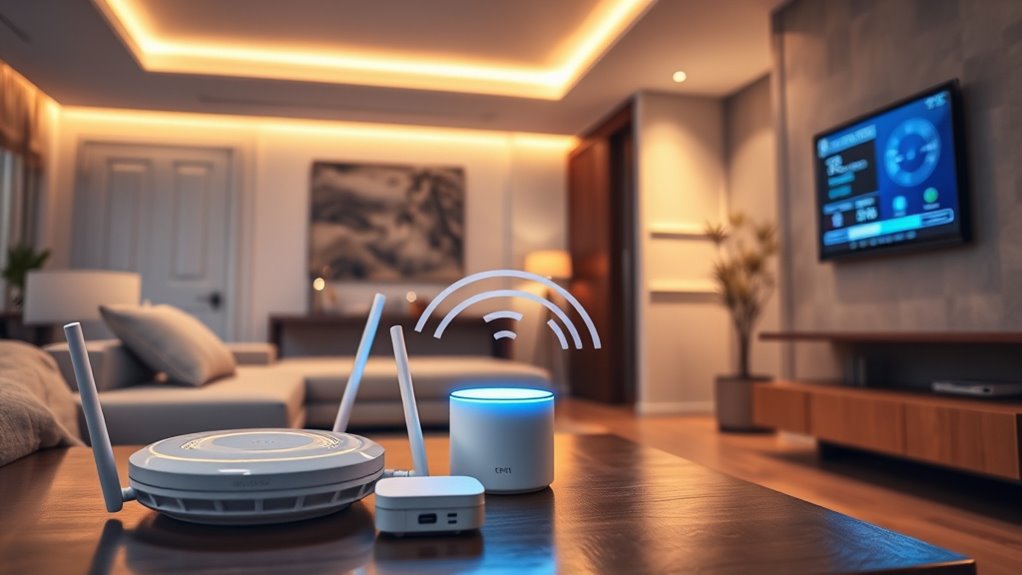Smart home devices emit low levels of electromagnetic fields (EMFs), mainly from Wi-Fi routers, smart speakers, and security cameras. Most emit within safety limits set by standards like FCC and ICNIRP, especially when they’re used properly and kept at a distance. You can reduce exposure by turning off devices when not in use or creating EMF-free zones. To discover simple ways to stay safe while enjoying your smart home, keep exploring these important facts.
Key Takeaways
- Most smart home devices emit EMFs within safety standards like FCC and ICNIRP guidelines.
- EMF levels decrease rapidly with distance; proper placement can reduce exposure.
- Regular EMF testing identifies hotspots and ensures devices operate within safe limits.
- Turning off Wi-Fi routers and smart devices when not in use minimizes unnecessary EMF emissions.
- Creating EMF-free zones in bedrooms and using wired connections can lower overall exposure.
Understanding Electromagnetic Fields and Their Sources

Electromagnetic fields (EMFs) are invisible areas of energy produced by electrical devices and wireless technologies that surround us daily. They originate from various sources like power lines, household appliances, Wi-Fi routers, and mobile phones. These fields are a natural part of our environment, but human-made EMFs have increased with technological advancements. EMFs are categorized into two types: extremely low frequency (ELF) from electrical wiring and appliances, and radiofrequency (RF) from wireless devices. While EMFs are invisible, their presence is measurable, and they can penetrate our bodies. Understanding the different sources of EMFs helps you recognize where exposure occurs and how technology contributes to these invisible energy fields in your everyday surroundings. Additionally, awareness of environmental considerations can help minimize potential impacts of EMF exposure on health and ecosystems.
How Much EMF Do Smart Home Devices Emit?
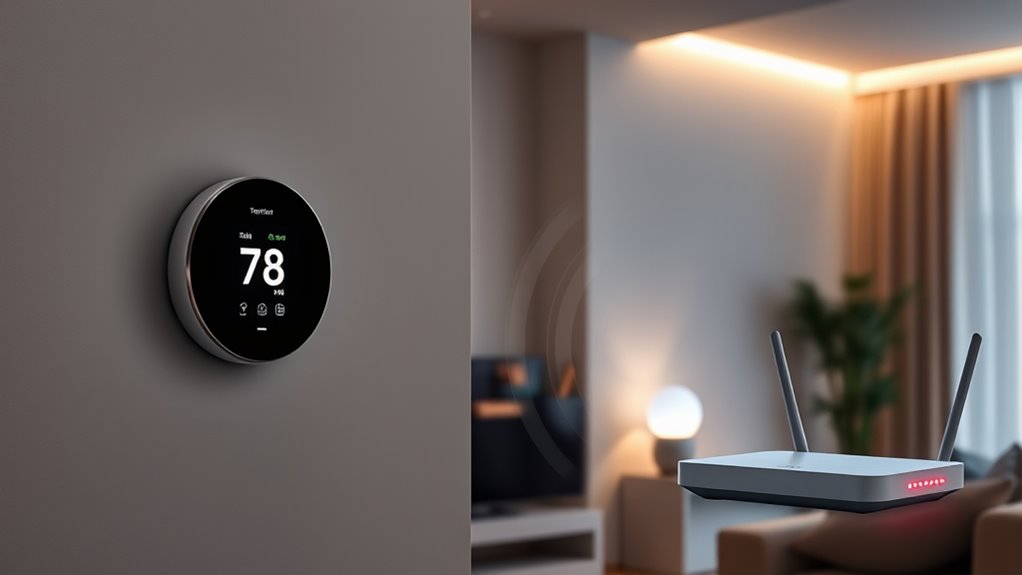
Smart home devices emit varying levels of EMF, but most stay within safe ranges. You might wonder how these emissions compare to other common sources of electromagnetic fields. Let’s look at typical EMF levels and how different devices stack up.
Typical EMF Levels
While many people worry about exposure from smart home devices, the actual electromagnetic fields (EMF) they emit are typically quite low. Most smart devices, like smart speakers, thermostats, and security cameras, produce EMF levels well below safety guidelines set by organizations like the FCC and ICNIRP. For example, Wi-Fi routers generally emit EMF levels comparable to other household electronics, often measured in microwatts per square centimeter. Smartphones, which are more frequently in use, emit similar low levels during typical operation. These measurements are usually far below the thresholds that could cause biological effects. Overall, the EMF levels from smart home devices are minimal, making them safe for everyday use for most people. GMC tuning techniques and safety standards further support that the EMF exposure remains within safe limits.
Comparing Device Emissions
Although many devices emit low levels of EMF, the amount varies considerably depending on the type and function. For example, smart thermostats generally emit minimal RF radiation, while Wi-Fi routers and smart cameras tend to produce higher emissions. Devices that constantly transmit data, like smart speakers or security systems, typically emit more EMF than passive gadgets. The distance from the device also matters; emissions decrease rapidly as you move farther away. Some devices operate at low power levels, making their exposure negligible, while others use higher power, increasing potential exposure. Comparing emissions helps you make informed choices about which devices to use and how to position them in your home to minimize EMF exposure. Additionally, understanding the types of EMF emissions from various devices can assist in implementing effective safety measures.
Comparing EMF Levels From Different Common Devices
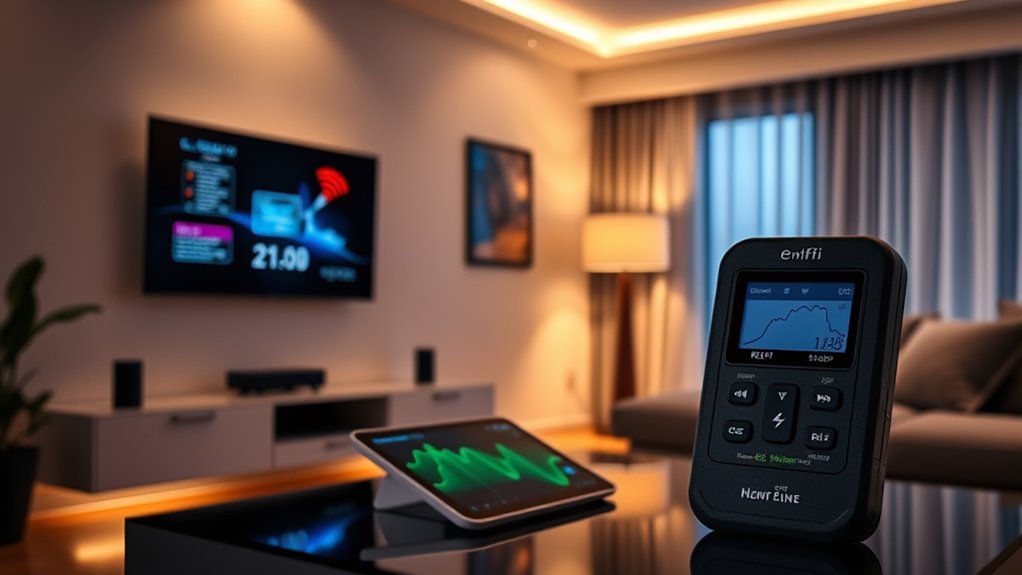
You might be surprised how much EMF exposure varies between common devices. Smartphones tend to emit higher levels during calls, while smart home devices generally produce lower, more consistent EMFs. Understanding these differences can help you make smarter choices about device use in your home. Additionally, awareness of tuning options for various vehicles can inform your decisions on customizing device settings for lower EMF emissions.
Smartphone EMF Emissions
Smartphones emit electromagnetic fields (EMF) during regular use, but their levels vary markedly compared to other common devices. When you make calls or stream data, your phone radiates radiofrequency (RF) energy, but these levels are generally lower than those from Wi-Fi routers or cordless phones. The specific absorption rate (SAR) measures how much RF energy your body absorbs, and smartphones are designed to stay within safety limits set by regulatory agencies. While your phone’s EMF emissions are higher during active use, they decrease considerably when idle or in standby mode. Overall, smartphone EMF exposure is relatively controlled, but prolonged or close contact can increase absorption. Comparing these levels with other devices helps you better understand your overall EMF exposure. Additionally, tuning of devices can influence their EMF emissions and efficiency.
Smart Home Device Levels
Different common smart home devices emit varying levels of electromagnetic fields (EMF), and understanding these differences can help you manage your exposure. For example, Wi-Fi routers typically produce higher EMF levels when actively transmitting data, but these levels are usually within safety guidelines. Smart speakers and voice assistants generate lower EMF emissions, mainly during use, and their fields decrease rapidly with distance. Devices like smart meters can emit intermittent EMFs, depending on data transmission schedules. Bluetooth devices tend to emit lower EMFs compared to Wi-Fi, but they are closer to your body during use. By comparing these levels, you can decide where to place devices or limit their use, especially in spaces where you spend a lot of time. Being aware of these differences helps you reduce unnecessary EMF exposure in your home. Additionally, understanding the contrast ratio of your devices can help optimize your viewing experience and reduce eye strain.
Potential Health Concerns Linked to EMF Exposure
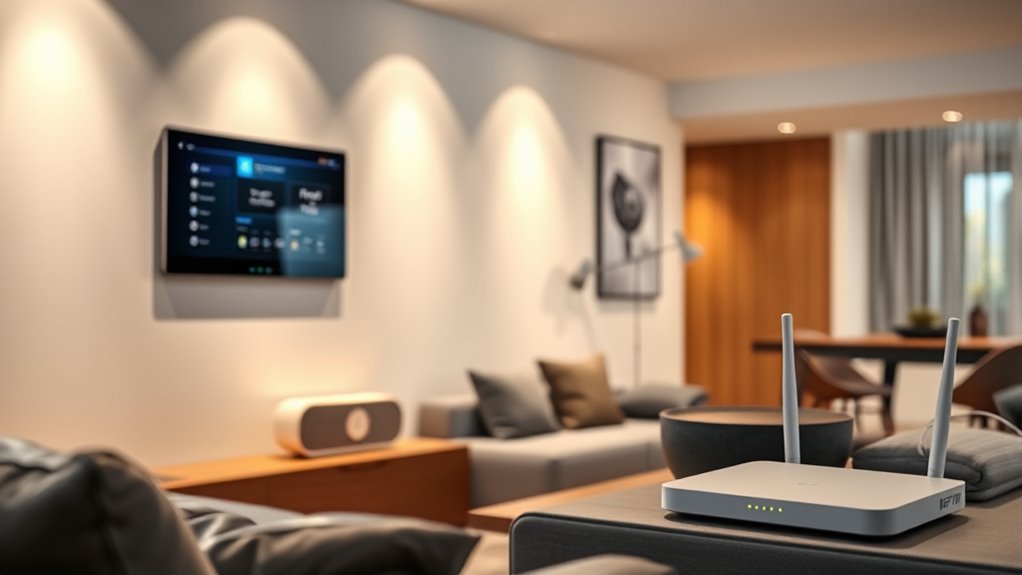
Although research on EMF exposure from smart home devices is ongoing, some studies suggest potential health concerns. You might worry about long-term effects like headaches, fatigue, or sleep disturbances. Certain researchers have explored links between EMF exposure and more serious conditions, such as increased cancer risk or neurological issues. However, the evidence remains inconclusive, and many experts emphasize that current exposure levels from smart devices are generally low. It’s important to stay informed and monitor ongoing research. While no definitive cause-and-effect relationships have been established, it’s wise to minimize unnecessary exposure when possible. Being cautious helps you manage potential risks without causing undue alarm, especially as science continues to explore the full impact of EMFs on health. Additionally, understanding vetted safety standards for smart devices can help you make more informed decisions about their use.
Guidelines and Safety Standards for EMF Emissions
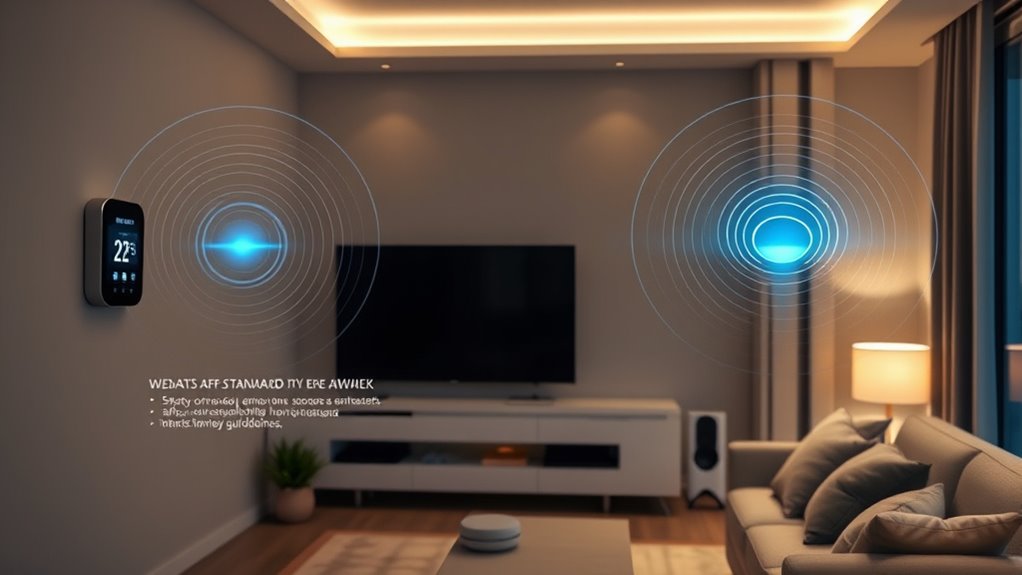
To guarantee that EMF emissions from smart home devices remain within safe limits, various organizations have established guidelines and safety standards. These standards set exposure limits to protect your health and ensure device safety. The International Commission on Non-Ionizing Radiation Protection (ICNIRP) and the Federal Communications Commission (FCC) are key bodies defining these limits. They measure EMF in units like SAR (Specific Absorption Rate) and power density. Compliance with these standards indicates that devices emit EMF levels below harmful thresholds. Always check device labels or manufacturer info for compliance marks. Material durability and proper testing procedures further ensure safety and longevity of devices.
Practical Tips to Reduce EMF Exposure at Home

You can effectively reduce your EMF exposure at home by making simple yet intentional adjustments to your daily routines and device usage. Here are some practical tips:
- Limit device usage: Turn off Wi-Fi routers and smart devices when not in use, especially overnight.
- Increase distance: Keep devices like smartphones and tablets away from your body; use speakerphone or headsets.
- Reduce wireless reliance: Use wired internet connections instead of Wi-Fi whenever possible.
- Create EMF-free zones: Designate areas in your home where electronics are minimized, such as bedrooms, to lower exposure during rest.
- Be aware of family photoshoot fails, which often involve unplanned disruptions and humorous moments caused by pets or children, reminding us to stay mindful of our environment and routines.
Implementing these steps helps minimize EMF exposure without sacrificing the convenience of smart technology.
Balancing Technology Benefits With Health Considerations

Balancing the advantages of smart home devices with potential health concerns requires mindful choices. While these devices offer convenience, security, and energy efficiency, it’s essential to contemplate their EMF exposure. You can enjoy the benefits by placing devices away from where you spend the most time, such as bedrooms and living rooms. Regularly turning off or unplugging devices when not in use reduces unnecessary exposure. Opt for products with lower EMF emissions and check for features like Wi-Fi scheduling or low-power modes. Educating yourself about the risks helps you make informed decisions, ensuring your smart home enhances your life without compromising health. Implementing data privacy measures also helps protect your personal information from potential misuse. Striking this balance allows you to enjoy modern technology responsibly and safely.
Frequently Asked Questions
Are There Any Long-Term Health Studies on Smart Home EMF Exposure?
You’re wondering if any long-term health studies exist on EMF exposure from smart home devices. Currently, research is limited, and exhaustive long-term studies are scarce. While some studies suggest low-level EMF exposure might have minimal effects, definitive conclusions haven’t been reached. It’s wise to stay informed about new research and consider reducing unnecessary exposure when possible, especially if you’re concerned about potential health risks.
Can EMF Exposure From Smart Devices Cause Immediate Health Symptoms?
Imagine a gentle whisper of discomfort when you’re near certain signals. While some people report immediate symptoms like headaches or dizziness from EMF exposure, scientific evidence doesn’t confirm a direct cause-and-effect. You might notice subtle sensations, but these aren’t necessarily harmful. It’s wise to stay informed, minimize unnecessary exposure, and listen to your body’s signals. Your well-being depends on balancing technology use with your comfort and health.
Which Smart Home Devices Emit the Highest Levels of EMF?
You wonder which smart home devices emit the highest levels of EMF. Generally, devices with wireless communication, like Wi-Fi routers, baby monitors, and cordless phones, tend to produce more EMF than other gadgets. These devices constantly transmit signals, resulting in higher EMF exposure. To reduce your exposure, keep a safe distance from these devices when possible and turn them off when not in use.
Are Children More Vulnerable to EMF Exposure From Smart Devices?
You might think children are invincible, but they’re actually much more vulnerable to EMF exposure from smart devices. Their developing bodies are like sponges, soaking up more radiation than adults. You should be extra cautious because even small amounts can have big impacts on their health. Prioritize limiting their exposure and encourage safe device use to protect their growing bodies from potential harm caused by EMFs.
How Does EMF Exposure From Smart Devices Compare to Natural Background Radiation?
When comparing EMF exposure from smart devices to natural background radiation, you find that natural radiation comes from sources like the sun and soil, and is generally much higher. Smart devices emit low-level non-ionizing radiation, which is less harmful. You’re exposed to natural sources constantly, while device emissions are typically minimal. Overall, the EMF levels from smart devices are usually far below natural background radiation, making them relatively safe.
Conclusion
While smart home devices might seem harmless, their EMF emissions could be silently transforming your home into an electromagnetic battleground! Imagine a world where every beep, buzz, and signal is quietly bombarding your body—dangerous levels lurking unnoticed. Stay informed, follow safety tips, and strike a smart balance between convenience and health. Because ignoring EMF exposure could turn your peaceful home into an invisible battlefield—don’t let technology secretly take over your well-being!
